Dynamics of Polyphenol Biosynthesis by Calli Cultures, Suspension Cultures and Wild Specimens of the Medicinal Plant Ligaria cuneifolia (Ruiz & Pav.) Tiegh. (Loranthaceae). Analysis of Their Biological Activity
Abstract
1. Introduction
2. Results
2.1. Dynamics of Polyphenols in Different Organs and Phenological Stages of Wild Plants
2.1.1. Spectrophotometric Analysis
2.1.2. Thin-Layer Chromatography (TLC) Analysis
2.1.3. HPLC-UV Analysis
2.1.4. Histochemical Analysis
2.2. In Vitro Culture Initiation, Growth Kinetics, and Polyphenolic Content under Different Culture Conditions
2.2.1. Light Influence on Calli Induction, Growth and Polyphenolic Content
2.2.2. Influence of PGRs and Inoculum Size on Growth Kinetics and Polyphenolic Content
2.2.3. Establishment of Cell Suspension Cultures. Growth Kinetics and Polyphenolic Content
2.3. Antioxidant Activity of Wild Plants and In Vitro Cultures
2.4. Mutagenicity and Antimutagenicity Assays of Wild Plants and In Vitro Culture Extracts
2.4.1. Mutagenicity Assay
2.4.2. Antimutagenicity Assay
3. Discussion
4. Materials and Methods
4.1. Dynamics of Polyphenols in Different Organs and Phenological Stages of Wild Plants
4.1.1. Plant Material
4.1.2. Polyphenol Extraction
4.1.3. Spectrophotometric Analysis
- Total phenolics content
- Total flavonoid content
- Hydroxycinnamic acid content
- Proanthocyanidin content
4.1.4. Thin-Layer Chromatography (TLC) Analysis
4.1.5. HPLC-UV Analysis
4.1.6. Histochemical Analysis
4.2. In Vitro Culture Initiation, Growth Kinetics, and Polyphenolic Content under Different Culture Conditions
4.2.1. Light Influence on Calli Induction, Growth, and Polyphenolic Content
4.2.2. Influence of PGRs and Inoculum Size on Growth Kinetics and Polyphenolic Content
4.2.3. Establishment of Cell Suspension Cultures
4.3. Antioxidant Activity of Wild Plants and In Vitro Cultures Extracts
4.4. Mutagenicity and Antimutagenicity Assays of Wild Plants and In Vitro Culture Extracts
4.4.1. Mutagenicity Assay
4.4.2. Antimutagenicity Assay
4.5. Chemicals and Reagents
5. Conclusions
Author Contributions
Funding
Institutional Review Board Statement
Informed Consent Statement
Data Availability Statement
Acknowledgments
Conflicts of Interest
References
- Amico, G.C.; Vidal-Russell, R.V. Uso de hospedadores por el muérdago Argentino Ligaria cuneifolia (Loranthaceae) a lo largo de su distribución geográfica. Boletín Soc. Argent. Botánica 2019, 54, 395–403. [Google Scholar] [CrossRef]
- Scarpa, G.; Montani, M. Etnobotánica Médica de Las “Ligas” (Loranthaceae Sensu Lato) Entre Indígenas y Criollos de Argentina. Dominguenzia 2011, 27, 5–19. [Google Scholar]
- Varela, B.G.; Fernández, T.; Taira, C.; Cerdá Zolezzi, P.; Ricco, R.A.; López, E.C.; Álvarez, É.; Gurni, A.A.; Hajos, S.; Wagner, M.L. El “Muérdago Criollo”, Ligaria Cuneifolia (R. et. P.) Tiegh—Loranthaceae—Desde El Uso Popular Hacia El Estudio de Los Efectos Farmacológicos. Dominguezia 2000, 17, 31–50. [Google Scholar]
- Dominighini, A.; Ferrero, M.; Crosetti, D.; Ronco, M.T.; Gonzálvez, J.; Urli, L.; Wagner, M.; Gurni, A.; Carnovale, C.E.; Luquita, A. Effects of proanthocyanidin enriched extract from Ligaria cuneifolia on plasma cholesterol and hemorheological parameters. In vivo and In vitro studies. Clin. Hemorheol. Microcirc. 2015, 60, 317–325. [Google Scholar] [CrossRef]
- Gonzalvez, J.E.; Garcia, G.; Galliano, S.; Dominighini, A.; Urli, L.; Monti, J.; Ronco, M.T.; Francés, D.; Wagner, M.; Carnovale, C.E.; et al. The Enriched Proanthocyanidin Extract of Ligaria cuneifolia Shows a Marked Hypocholesterolemic Effect in Rats Fed with Cholesterol- Enriched Diet. Recent Patents Endocrine Metab. Immune Drug Discov. 2018, 11, 47–53. [Google Scholar] [CrossRef]
- Zolezzi, P.C.; Fernández, T.; Aulicino, P.; Cavaliere, V.; Greczanik, S.; Lopes, E.C.; Wagner, M.; Ricco, R.; Gurni, A.; Hajos, S.; et al. Ligaria cuneifolia flavonoid fractions modulate cell growth of normal lymphocytes and tumor cells as well as multidrug resistant cells. Immunobiology 2005, 209, 737–749. [Google Scholar] [CrossRef]
- Papademetrio, D.L.; Trabucchi, A.; Cavaliere, V.; Ricco, R.; Costantino, S.; Wagner, M.L.; Álvarez, E. The catechin flavonoid reduces proliferation and induces apoptosis of murine lymphoma cells LB02 through modulation of antiapoptotic proteins. Rev. Bras. Farm. 2013, 23, 455–463. [Google Scholar] [CrossRef]
- Soberón, J.R.; Sgariglia, M.A.; Maderuelo, M.R.D.; Andina, M.L.; Sampietro, D.A.; Vattuone, M.A. Antibacterial activities of Ligaria cuneifolia and Jodina rhombifolia leaf extracts against phytopathogenic and clinical bacteria. J. Biosci. Bioeng. 2014, 118, 599–605. [Google Scholar] [CrossRef]
- Aguirre, A.; Borneo, R. Antioxidant Effects of Four Native Medicinal Plants Collected in Córdoba. Mol. Med. Chem. 2010, 21, 1–3. [Google Scholar]
- Dobrecky, C.B.; Moreno, E.; Garcés, M.; Lucangioli, S.; Ricco, R.; Evelson, P.; Wagner, M.L. Contenido de Polifenoles En Ligaria Cuneifolia y Su Relación Con La Capacidad Antioxidante Polyphenol Composition in Ligaria Cuneifolia (Loranthaceae) and Its Relationship with the Antioxidant Capacity. Dominguezia 2014, 30, 35–39. [Google Scholar]
- Dobrecky, C.B. Variación de Los Perfiles de Polifenoles En Ligaria Cuneifolia (R. et. P.) Tiegh (Loranthaceae), Su Estudio Mediante Electroforesis Capilar y Su Relación Con La Actividad Farmacológica. Polyphen. Profile Var. Ligaria Cuneifolia 2020, 36, 5–10. [Google Scholar]
- Gerschcovsky, N.; Knox, M.; Carnovale, C.; Wagner, M.; Vinet, R.; Luquita, A. Efecto Biológico de Proantocianidina Extraída de Ligaria Cuneifolia Sobre La Contractibilidad de Aorta Aislada de Rata. In VI Congreso Latinoamericano de Plantas Medicinales; Universidad Nacional de Trujillo: Trujillo, Perú, 2018; p. 38. [Google Scholar]
- Taira, C.; Wagner, M.; Gurni, A. Pharmacological and Cardiovascular Aspects of Ligaria Cuneifolia Infusions. Pharm. Biol. 2004, 42, 234–239. [Google Scholar] [CrossRef]
- Fernández, T.; Wagner, M.L.; Varela, B.G.; Ricco, R.A.; Hajos, S.E.; Gurni, A.A.; Alvarez, E. Study of an Argentine Mistletoe, the hemiparasite Ligaria cuneifolia (R. et. P.) Tiegh. (Loranthaceae). J. Ethnopharmacol. 1998, 62, 25–34. [Google Scholar] [CrossRef]
- Dobrecky, C.B.; Flor, S.A.; López, P.G.; Wagner, M.L.; Lucangioli, S.E. Development of a novel dual CD-MEKC system for the systematic flavonoid fingerprinting of Ligaria cuneifolia (R. et P.) Tiegh.-Loranthaceae-extracts. Electrophoresis 2017, 38, 1292–1300. [Google Scholar] [CrossRef] [PubMed]
- Chepel, V.; Lisun, V.; Skrypnik, L. Changes in the Content of Some Groups of Phenolic Compounds and Biological Activity of Extracts of Various Parts of Heather (Calluna vulgaris (L.) Hull) at Different Growth Stages. Plants 2020, 9, 926. [Google Scholar] [CrossRef]
- Wagner, M.L.; Idrogo, C.R.; Paredes, G.E.D.; Ballona, J.P.B. In vitro tissue culture, preliminar phytochemical analysis, and antibacterial activity of Psittacanthus linearis (Killip) J.K. Macbride (Loranthaceae). Rev. Colomb. Biotecnol. 2019, 21, 22–35. [Google Scholar] [CrossRef]
- Deeks, S.J.; Shamoun, S.F.; Punja, Z.K. Tissue culture of parasitic flowering plants: Methods and applications in agriculture and forestry. In Vitro Cell. Dev. Biol. 1999, 35, 369–381. [Google Scholar] [CrossRef]
- Ricco, M.V.; Bari, M.L.; Bagnato, F.; Cornacchioli, C.; Laguia-Becher, M.; Spairani, L.U.; Posadaz, A.; Dobrecky, C.; Ricco, R.A.; Wagner, M.L.; et al. Establishment of callus-cultures of the Argentinean mistletoe, Ligaria cuneifolia (R. et. P.) Tiegh (Loranthaceae) and screening of their polyphenolic content. Plant Cell Tissue Organ Cult. 2019, 138, 167–180. [Google Scholar] [CrossRef]
- Nigra, H.M.; Alvarez, M.A.; Giulietti, A.M. Effect of carbon and nitrogen sources on growth and solasodine production in batch suspension cultures of Solanum eleagnifolium Cav. Plant Cell Tissue Organ Cult. 1990, 21, 55–60. [Google Scholar] [CrossRef]
- Alvarez, M.A. Plant Biotechnology for Health: From Secondary Metabolites to Molecular Farming; Springer: Berlin/Heidelberg, Germany, 2014. [Google Scholar] [CrossRef]
- Jamwal, K.; Bhattacharya, S.; Puri, S. Plant growth regulator mediated consequences of secondary metabolites in medicinal plants. J. Appl. Res. Med. Aromat. Plants 2018, 9, 26–38. [Google Scholar] [CrossRef]
- Phillips, G.C.; Garda, M. Plant tissue culture media and practices: An overview. In Vitro Cell. Dev. Biol. Anim. 2019, 55, 242–257. [Google Scholar] [CrossRef]
- Wagner, M.L.; Dobrecky, C.B.; Varela, B.G.; Luquita, A.N.; Carnovale, C.E.; Álvarez, M.A.; Ricco, R.A. Ligaria cuneifolia (R. et. P.) Tiegh. In Medicinal and Aromatic Plants of South America Volume 2. Medicinal and Aromatic Plants of the World, Volume 7; Máthé, Á., Bandoni, A., Eds.; Springer Nature: Cham, Switzerland, 2021; pp. 295–310. [Google Scholar] [CrossRef]
- Verma, N.; Shukla, S. Impact of various factors responsible for fluctuation in plant secondary metabolites. J. Appl. Res. Med. Aromat. Plants 2015, 2, 105–113. [Google Scholar] [CrossRef]
- Pietrzak, W.; Nowak, R. Impact of Harvest Conditions and Host Tree Species on Chemical Composition and Antioxidant Activity of Extracts from Viscum album L. Molecules 2021, 26, 3741. [Google Scholar] [CrossRef]
- Alvarez, M.A. Pharmacological Properties of Native Plants from Argentina; Springer: Cham, Switzerland, 2019. [Google Scholar] [CrossRef]
- Stefanucci, A.; Zengin, G.; Llorent-Martinez, E.J.; Dimmito, M.P.; Della Valle, A.; Pieretti, S.; Ak, G.; Sinan, K.I.; Mollica, A. Viscum album L. homogenizer-assisted and ultrasound-assisted extracts as potential sources of bioactive compounds. J. Food Biochem. 2020, 44, e13377. [Google Scholar] [CrossRef] [PubMed]
- Tsormpatsidis, E.; Henbest, R.G.C.; Davis, F.J.; Battey, N.H.; Hadley, P.; Wagstaffe, A. UV Irradiance as a Major Influence on Growth, Development and Secondary Products of Commercial Importance in Lollo Rosso Lettuce ‘Revolution’ Grown under Polyethylene Films. Environ. Exp. Bot. 2008, 63, 232–239. [Google Scholar] [CrossRef]
- Cao, Y.; Fang, S.; Fu, X.; Shang, X.; Yang, W. Seasonal Variation in Phenolic Compounds and Antioxidant Activity in Leaves of Cyclocarya paliurus (Batal.) Iljinskaja. Forests 2019, 10, 624. [Google Scholar] [CrossRef]
- Amaral, J.S.; Seabra, R.M.; Andrade, P.; Valentão, P.; Pereira, J.A.; Ferreres, F. Phenolic profile in the quality control of walnut (Juglans regia L.) leave. Food Chem. 2004, 88, 373–379. [Google Scholar] [CrossRef]
- Riihinen, K.; Jaakola, L.; Kärenlampi, S.; Hohtola, A. Organ-specific distribution of phenolic compounds in bilberry (Vaccinium myrtillus) and ‘northblue’blueberry (Vaccinium corymbosum × V. angustifolium). Food Chem. 2008, 110, 156–160. [Google Scholar] [CrossRef]
- Agudelo, I.J.; Bach, H.; Ricco, R.A.; Wagner, M.L. Structural Characteristics and Content of Polyphenolic Compounds in Healthy Organs and Galls Induced by Allodiplosis crassa Kieff. and Jörg (Cecydomyiidae, Diptera) on Geoffroea decorticans (Hook. and Arn.) Burkart (Leguminosae). Acta Phytopathol. Èntomol. Hung. 2021, 55, 259–274. [Google Scholar] [CrossRef]
- García-García, J.; Anguiano-Cabello, J.; Arredondo-Valdés, R.; del Toro, C.C.; Martínez-Hernández, J.; Segura-Ceniceros, E.; Govea-Salas, M.; González-Chávez, M.; Ramos-González, R.; Esparza-González, S.; et al. Phytochemical Characterization of Phoradendron bollanum and Viscum album subs. austriacum as Mexican Mistletoe Plants with Antimicrobial Activity. Plants 2021, 10, 1299. [Google Scholar] [CrossRef]
- Chesselet, P.; Wolfson, M.M.; Ellis, R. A comparative histochemical study of plant polyphenols in southern African grasses. J. Grassl. Soc. S. Afr. 1992, 9, 119–125. [Google Scholar] [CrossRef]
- Ellis, R.P. Tannin-like Substances in Grass Leaves. Mem. Bot. Surv. S. Afr. 1990, 59, 80. [Google Scholar]
- Peer, W.A.; Brown, D.E.; Tague, B.W.; Muday, G.K.; Taiz, L.; Murphy, A.S. Flavonoid Accumulation Patterns of Transparent Testa Mutants of Arabidopsis. Plant Physiol. 2001, 126, 536–548. [Google Scholar] [CrossRef] [PubMed]
- Kim, J.; Baek, S.; Lee, K.P.; Moon, B.S.; Kim, H.S.; Kwon, S.H.; Kim, J. Chlorogenic acid in Viscum album callus is a potential anticancer agent against C6 glioma cells. Pharmacogn. Mag. 2021, 16, 532–537. [Google Scholar] [CrossRef]
- Hall, P.J.; Letham, D.S.; Barlow, B.A. The Influence of Hormones on Development of Amyema Seedlings Cultured in Vitro. In Procedings of the 4th International Symposium on Parasitic Flowering Plants; Weber, H.C., Forstrenter, W., Eds.; Philips University: Marburg, Germany, 1987; pp. 285–291. [Google Scholar]
- Bajaj, I.P. Growth Responses of Excised Embryos of Some Mistletoes. Z. Phlanzenphysiol. 1970, 63, 408–415. [Google Scholar]
- Deeni, Y.; Sadiq, N. Antimicrobial properties and phytochemical constituents of the leaves of African mistletoe (Tapinanthus dodoneifolius (DC) Danser) (Loranthaceae): An ethnomedicinal plant of Hausaland, Northern Nigeria. J. Ethnopharmacol. 2002, 83, 235–240. [Google Scholar] [CrossRef]
- Idu, M.; Ovuakporie-Uvo, O.; Nwaokolo, M.J. Phytochemistry and microscopy of Tapinanthus dodoneifolius (DC) (Danser) (Santalales: Loranthaceae) (African mistletoes) from guava, rubber and orange host trees. Braz. J. Biol. Sci. 2016, 3, 27. [Google Scholar] [CrossRef]
- Zaprometov, M. Proanthocyanidins and Catechins. In Phytochemicals in Plant Cell Cultures; Academic Press: Cambridge, MA, USA, 1988; Volume 5, pp. 77–88. [Google Scholar] [CrossRef]
- Shipilova, S.V.; Koretzkaya, Τ.F.; Zaprometov, Μ.N. Phenylalanine ammonia-lyase and flavan synthesis in the tissue culture of tea-plant. Fiziol. Rast. Mosc. 1978, 25, 552–555. [Google Scholar]
- López-Laredo, A.R.; Ramírez-Flores, F.D.; Sepulveda-Jimenez, G.; Trejo-Tapia, G. Comparison of metabolite levels in callus of Tecoma stans (L.) Juss. ex Kunth. cultured in photoperiod and darkness. In Vitro Cell. Dev. Biol. Anim. 2009, 45, 550–558. [Google Scholar] [CrossRef]
- Kumar, S.S.; Arya, M.; Mahadevappa, P.; Giridhar, P. Influence of photoperiod on growth, bioactive compounds and antioxidant activity in callus cultures of Basella rubra L. J. Photochem. Photobiol. B Biol. 2020, 209, 111937. [Google Scholar] [CrossRef]
- Matkowski, A. Plant in vitro culture for the production of antioxidants—A review. Biotechnol. Adv. 2008, 26, 548–560. [Google Scholar] [CrossRef] [PubMed]
- Kandil, F.E.; Song, L.; Pezzuto, J.M.; Marley, K.; Seigler, D.S.; Smith, M.A.L. Isolation of oligomeric proanthocyanidins from flavonoid-producing cell cultures. In Vitro Cell. Dev. Biol. 2000, 36, 492–500. [Google Scholar] [CrossRef]
- Decendit, A.; Mérillon, J.M. Condensed tannin and anthocyanin production in Vitis vinifera cell suspension cultures. Plant Cell Rep. 1996, 15, 762–765. [Google Scholar] [CrossRef]
- Bajaj, Y.P.S. In Vitrostudies on the embryos of two Mistletoes, Amyema Pendula and Amyema Mi Quelii. N. Z. J. Bot. 1967, 5, 49–56. [Google Scholar] [CrossRef]
- Gupta, S.D.; Conger, B.V. Somatic Embryogenesis and Plant Regeneration from Suspension Cultures of Switchgrass. Crop. Sci. 1999, 39, 243–247. [Google Scholar] [CrossRef]
- Ibraheembr, Y.; Böhme, M.; Pinker, I. A comparative study between solid and liquid cultures relative to callus growth and somatic embryo formation in date palm (Phoenix dactylifera L.) cv. Zaghlool. Emir. J. Food Agric. 2013, 25, 883. [Google Scholar] [CrossRef]
- Fowler, M.W. Plant-Cell Culture: Natural Products and Industrial Application. Biotechnol. Genet. Eng. Rev. 1984, 2, 41–67. [Google Scholar] [CrossRef]
- Torres, K.C. Overview of Cell Suspension Culture. Tissue Cult. Tech. Hortic. Crop. 1989, 7, 151–160. [Google Scholar] [CrossRef]
- Mustafa, N.R.; De Winter, W.; Van Iren, F.; Verpoorte, R. Initiation, growth and cryopreservation of plant cell suspension cultures. Nat. Protoc. 2011, 6, 715–742. [Google Scholar] [CrossRef] [PubMed]
- Alvarez, M.A. Influencia de Reguladores de Crecimiento y Organogénesis Sobre La Producción de solasodina Por Cultivo In Vitro de Solanum eleagnifolium Cav. Ph.D. Thesis, Facultad de Farmacia y Bioquímica, Universidad de Buenos Aires, Buenos Aires, Argentina, 1992. [Google Scholar]
- Cisneros-Torres, D.; Cruz-Sosa, F.; González-Cortazar, M.; Martínez-Trujillo, A.; Nicasio-Torres, P. Enhancing the production of scopoletin and quercetin 3-O-β-d-glucoside from cell suspension cultures of Tilia americana var. Mexicana by modulating the copper and nitrate concentrations. Plant Cell Tissue Organ Cult. 2019, 139, 305–316. [Google Scholar] [CrossRef]
- Fidemann, T.; Pereira, G.A.D.A.; Heluy, T.R.; Gallego, R.B.; Bertão, M.R.; Da Silva, R.M.G.; Núñez, E.G.F. Handling culture medium composition for optimizing plant cell suspension culture in shake flasks. Plant Cell Tissue Organ Cult. 2017, 133, 137–146. [Google Scholar] [CrossRef]
- King, P.J.; Mansfield, K.J.; Street, H.E. Control of growth and cell division in plant cell suspension cultures. Can. J. Bot. 1973, 51, 1807–1823. [Google Scholar] [CrossRef]
- Tahirovic, A.; Basic, N. Determination of Phenolic Content and Antioxidant Properties of Methanolic Extracts from Viscum Album Ssp. Album Beck. Bull. Chem. Technol. Bosnia Herzeg. 2017, 49, 25–30. [Google Scholar]
- Makkar, H.P.S.; Blümmel, M.; Borowy, N.K.; Becker, K. Gravimetric determination of tannins and their correlations with chemical and protein precipitation methods. J. Sci. Food Agric. 1993, 61, 161–165. [Google Scholar] [CrossRef]
- Rafi, M.; Febriany, S.; Wulandari, P.; Suparto, I.H.; Ridwan, T.; Rahayu, S.; Siswoyo, D.M. Total Phenolics, Flavonoids, and Anthocyanin Contents of Six Vireya Rhododendron from Indonesia and Evaluation of their Antioxidant Activities. J. Appl. Pharm. Sci. 2018, 8, 49–54. [Google Scholar] [CrossRef]
- Ricco, R.A.; Agudelo, I.J.; Wagner, M.L. Métodos Empleados En El Análisis de Los Polifenoles En Un Laboratorio de Baja Complejidad. Lilloa 2015, 52, 161–174. [Google Scholar] [CrossRef][Green Version]
- Horszwald, A.; Andlauer, W. Characterisation of bioactive compounds in berry juices by traditional photometric and modern microplate methods. J. Berry Res. 2011, 1, 189–199. [Google Scholar] [CrossRef]
- The Jamovi Project. jamovi. 2021. Available online: https://www.jamovi.org (accessed on 18 August 2021).
- RStudio, R.T. Integrated Development for R. RStudio; Scientific Research: Boston, MA, USA, 2020. [Google Scholar]
- Wagner, H.; Bladt, S. Plant Drug Analisys: A Thin Layer Chromatography Atlas, 2nd ed.; Springer: Berlin, Germany, 1996. [Google Scholar]
- Dag, O.; Dolgun, A.; Naime, M.K. onewaytests: An R Package for One-Way Tests in Independent Groups Designs. R J. 2018, 10, 175–199. [Google Scholar] [CrossRef]
- Welch, B.L. On the Comparison of Several Mean Values: An Alternative Approach. Biometrika 1951, 38, 330–336. [Google Scholar] [CrossRef]
- Games, P.A.; Howell, J.F. Pairwise Multiple Comparison Procedures with Unequal N’s and/or Variances: A Monte Carlo Study. J. Educ. Stat. 1976, 1, 113–125. [Google Scholar] [CrossRef]
- Kirk, R. Experimental Design: Procedures for the Behavioral Sciences, 4th ed.; SAGE Publications, Inc.: Thousand Oaks, CA, USA, 2013. [Google Scholar] [CrossRef]
- Huang, C.-N.; Cornejo, M.J.; Bush, D.S.; Jones, R.L. Estimating viability of plant protoplasts using double and single staining. Protoplasma 1986, 135, 80–87. [Google Scholar] [CrossRef]
- Cheng, Z.; Moore, A.J.; Yu, L. High-Throughput Relative DPPH Radical Scavenging Capacity Assay. J. Agric. Food Chem. 2006, 54, 7429–7436. [Google Scholar] [CrossRef] [PubMed]
- Maron, D.M.; Ames, B.N. Revised methods for the Salmonella mutagenicity test. Mutat. Res. Mutagen. Relat. Subj. 1983, 113, 173–215. [Google Scholar] [CrossRef]
- White, P.R. The Cultivation of Animal and Plant Cells; Ronald Press: New York, NY, USA, 1963. [Google Scholar]
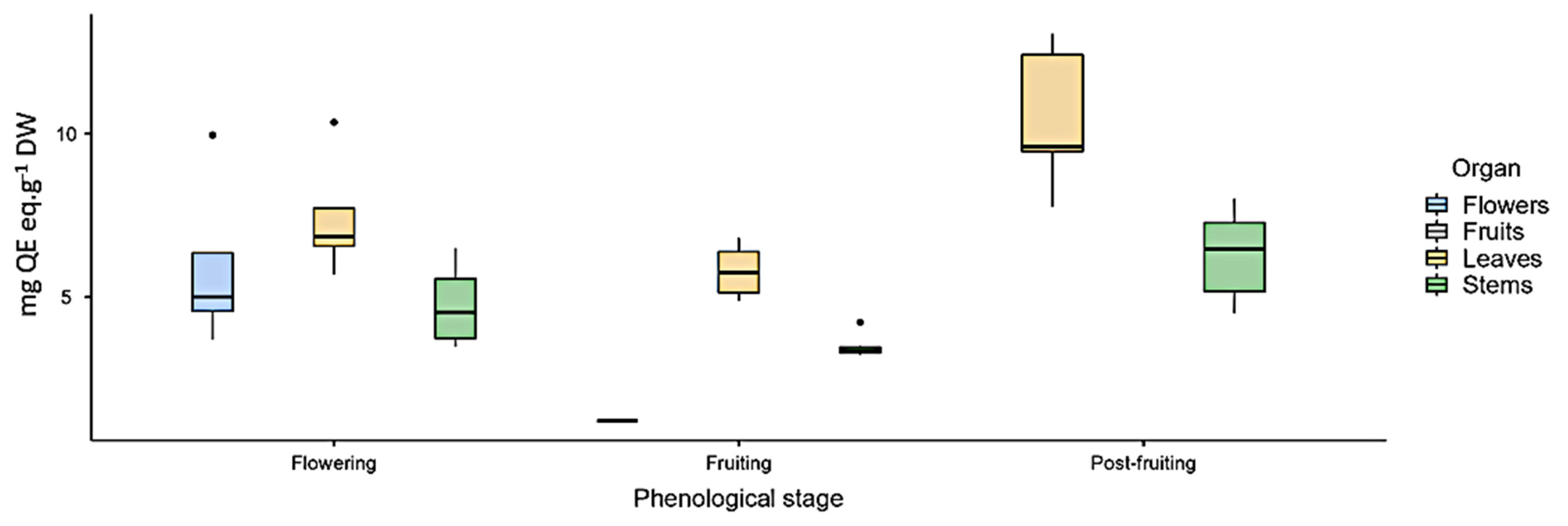
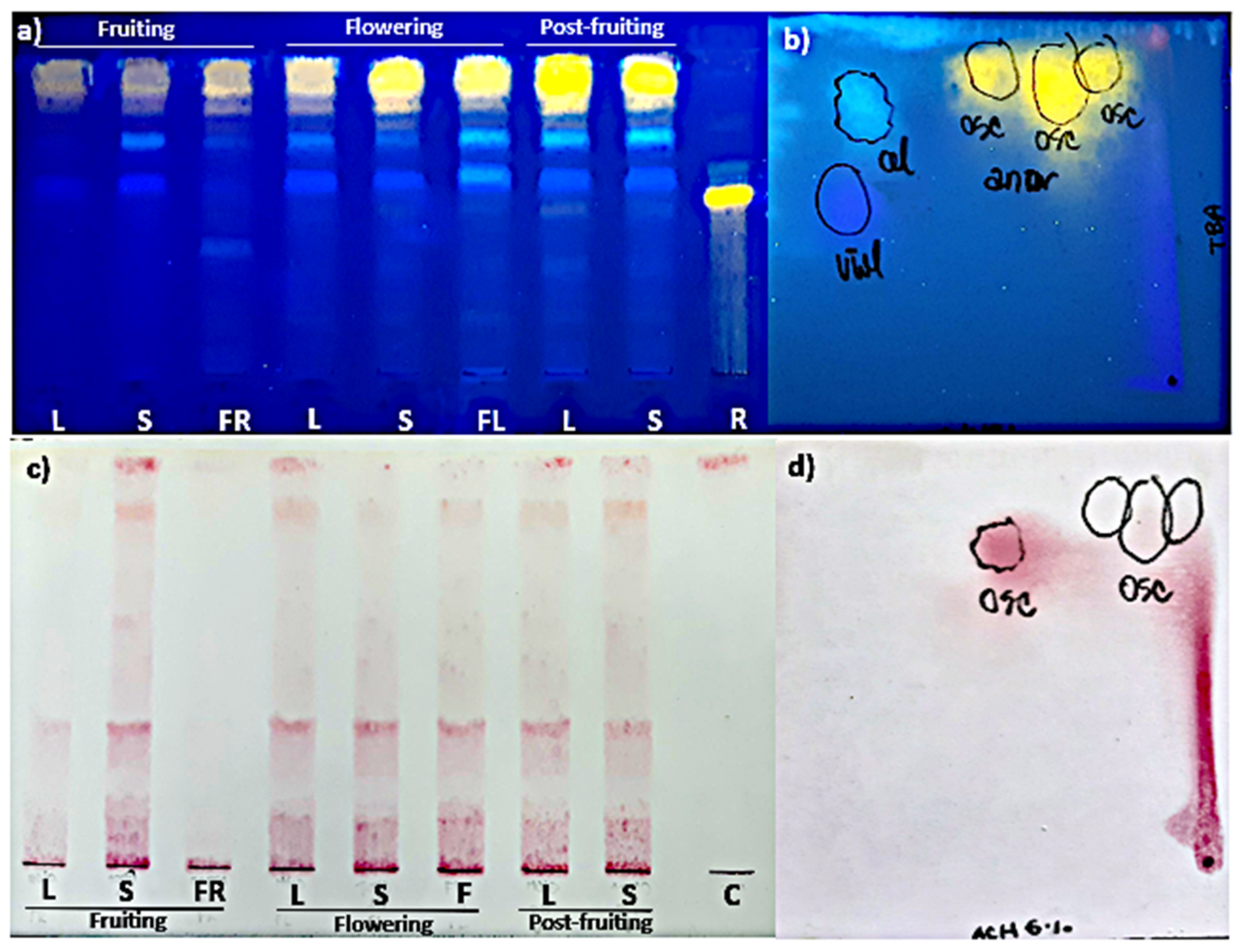
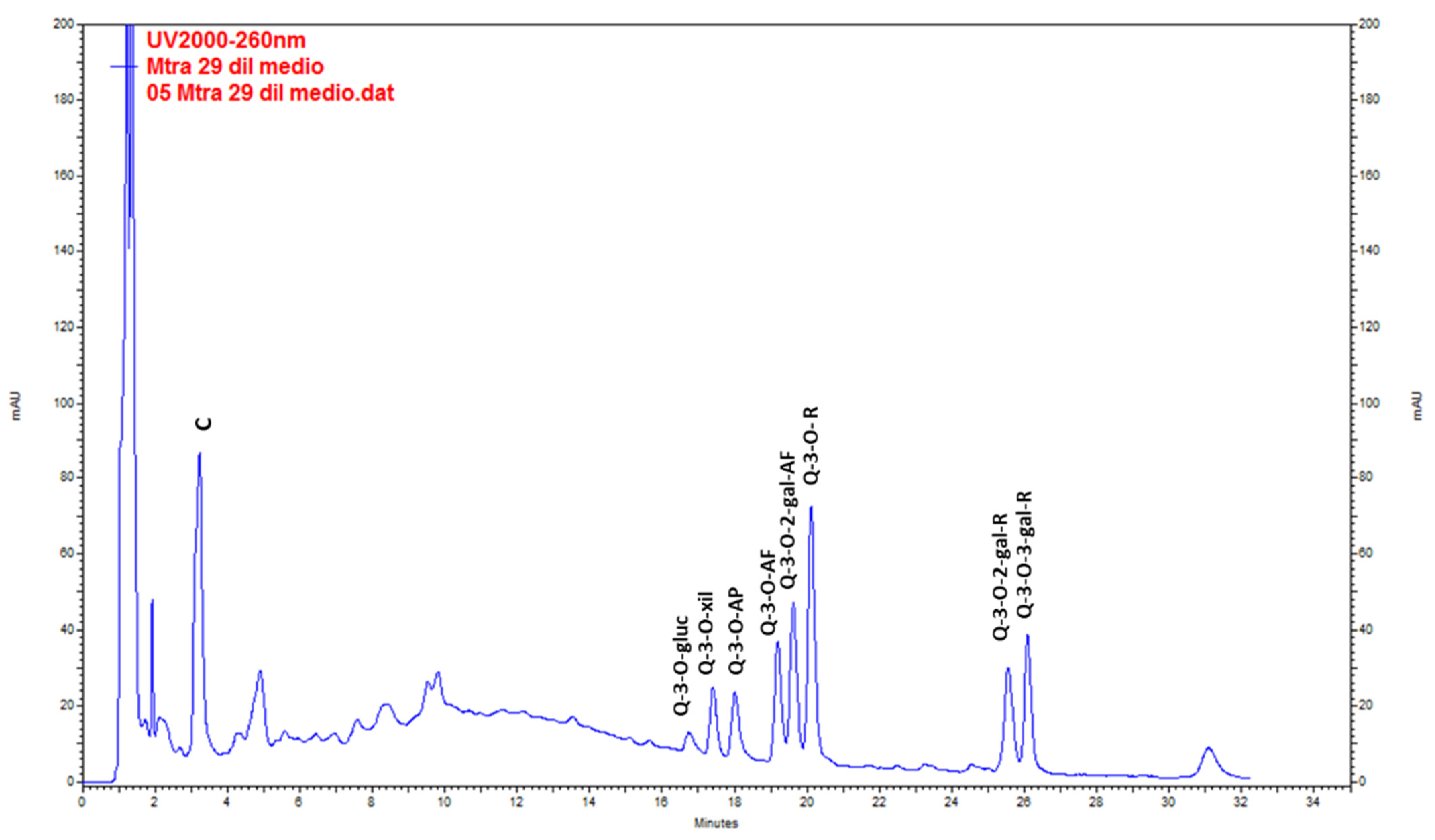
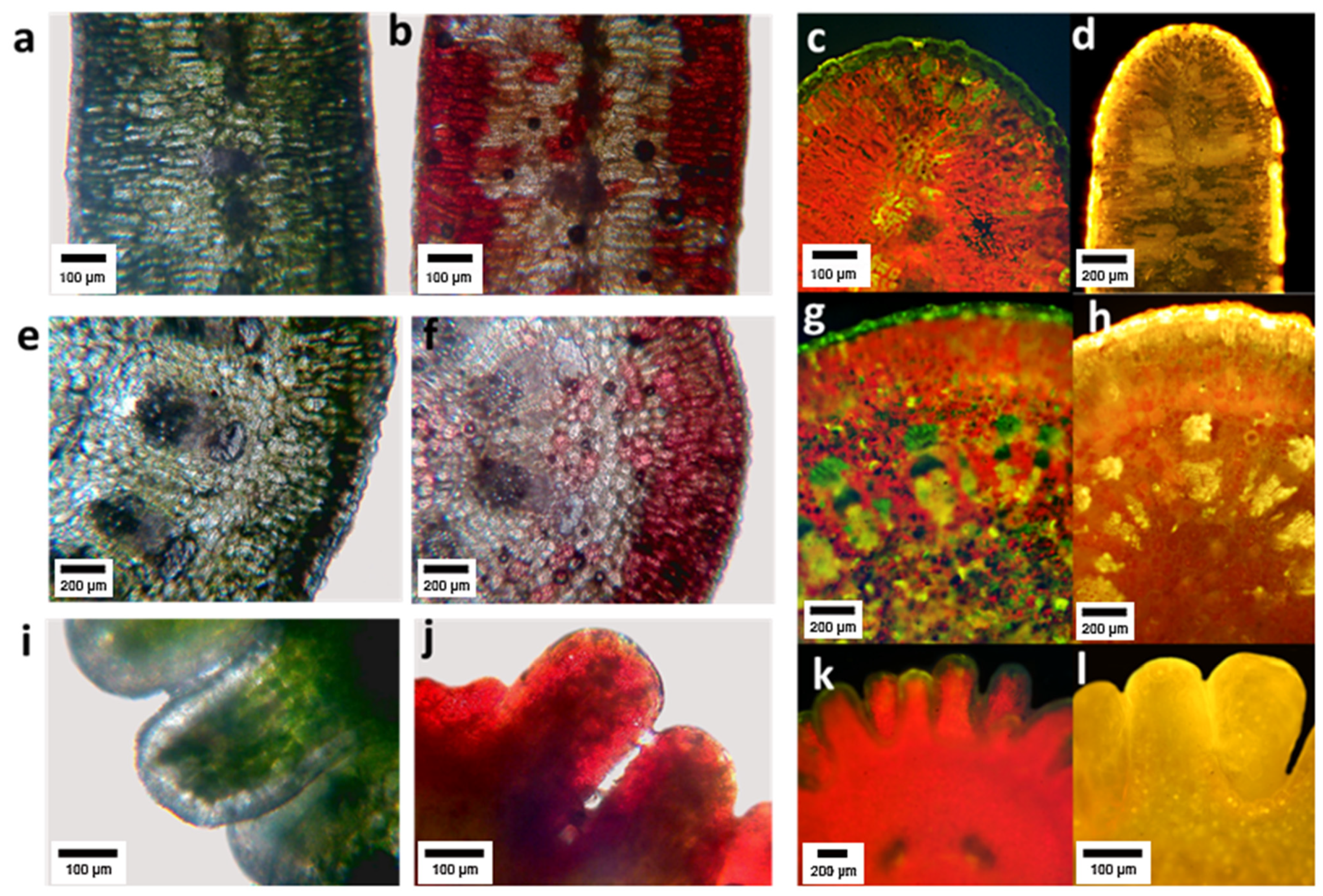
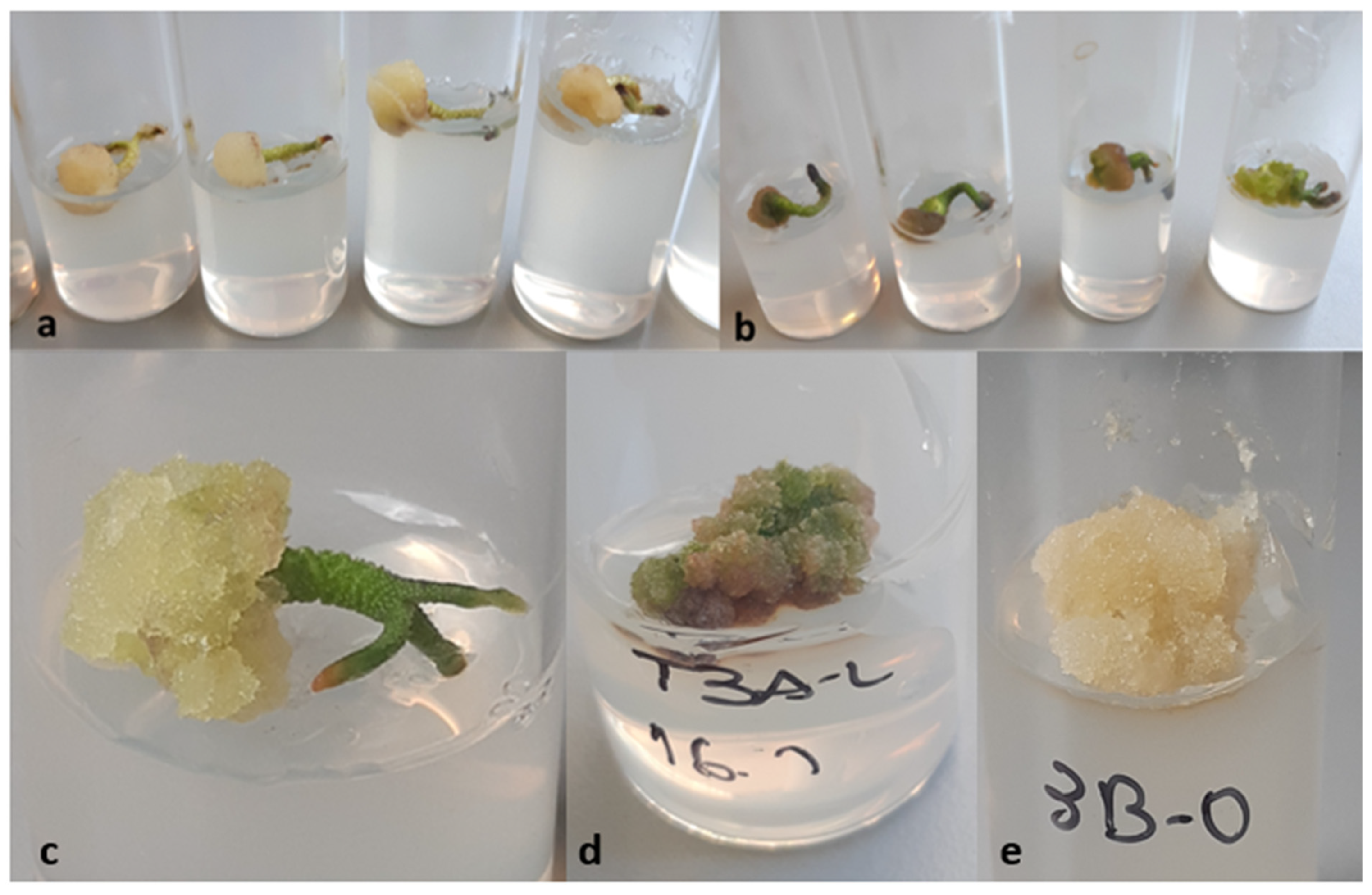
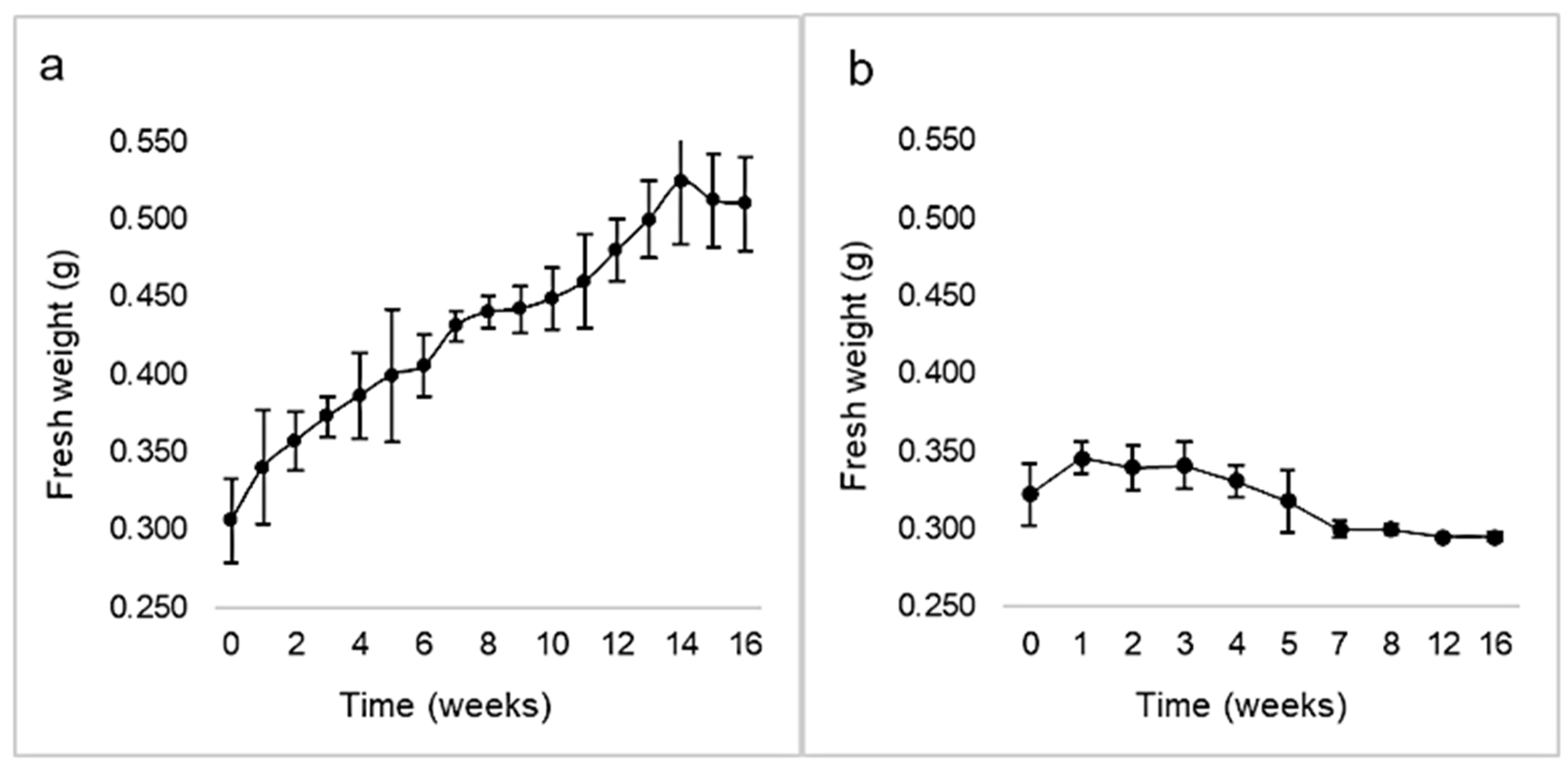
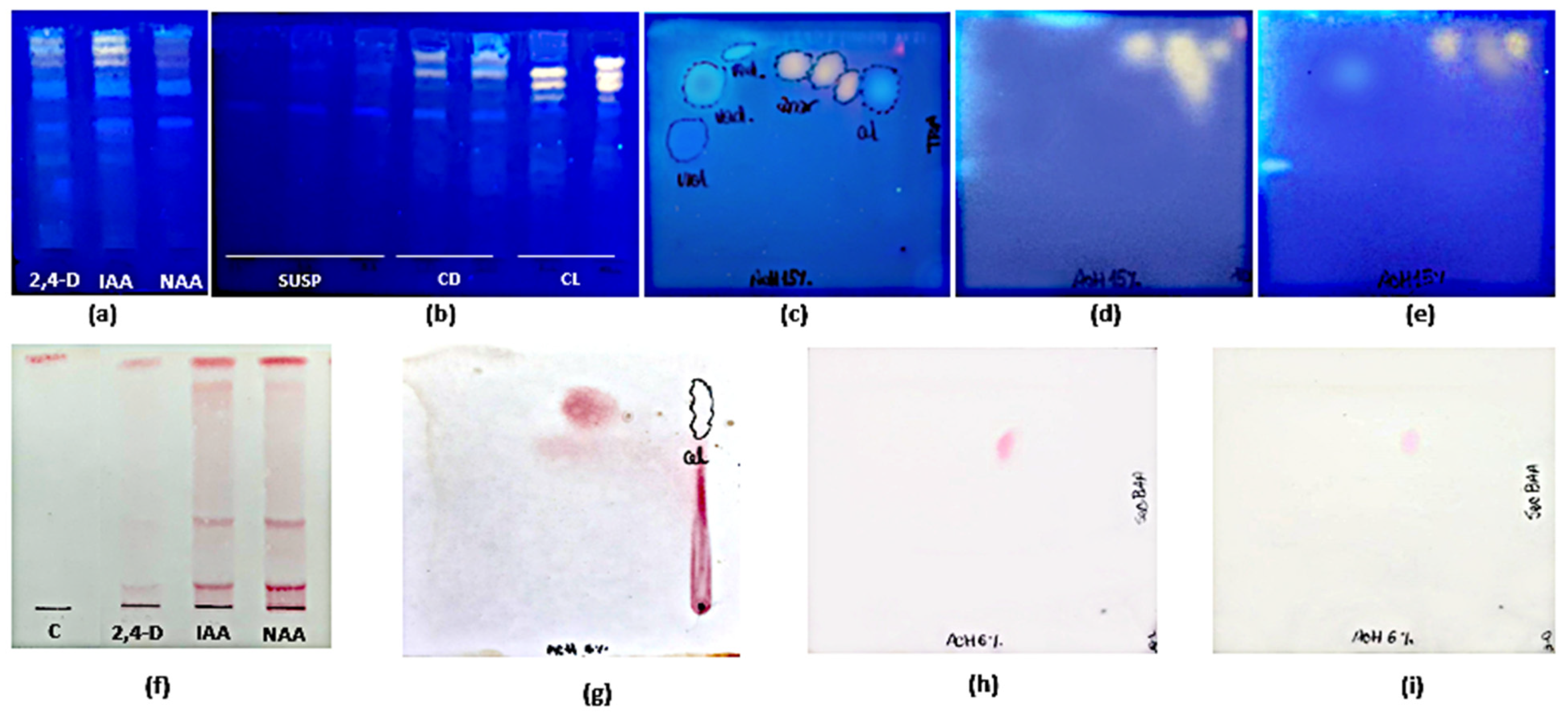


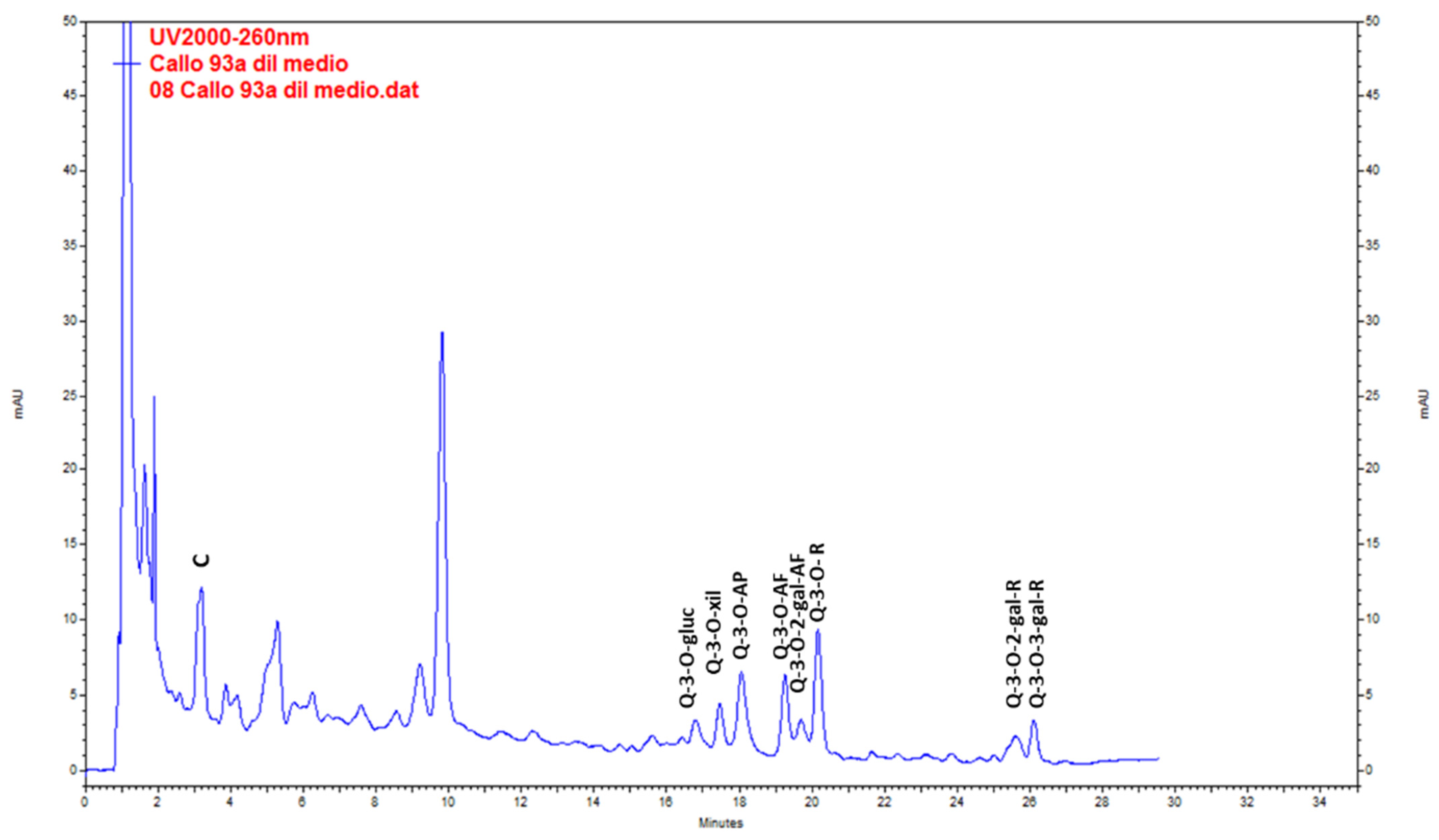
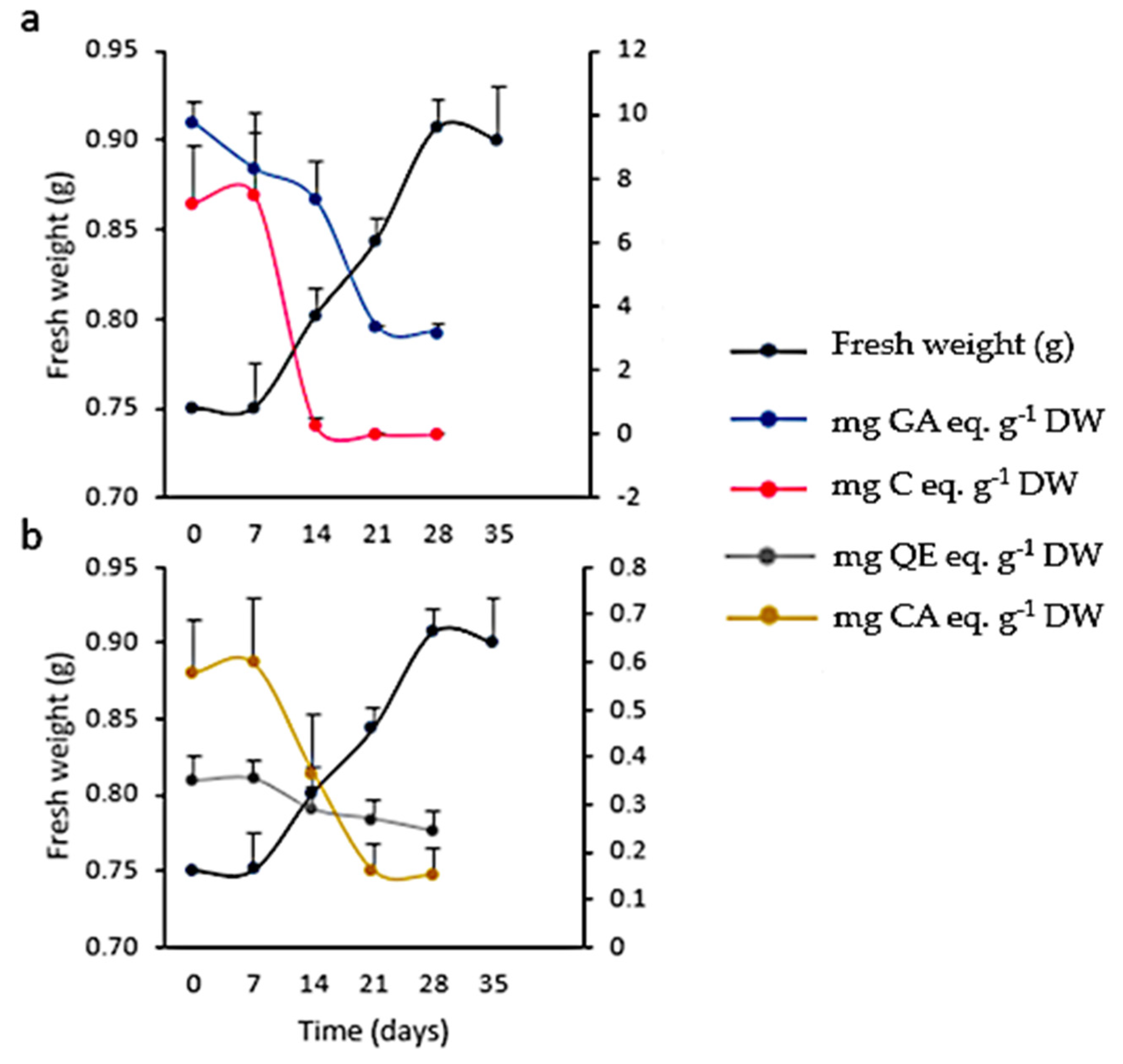

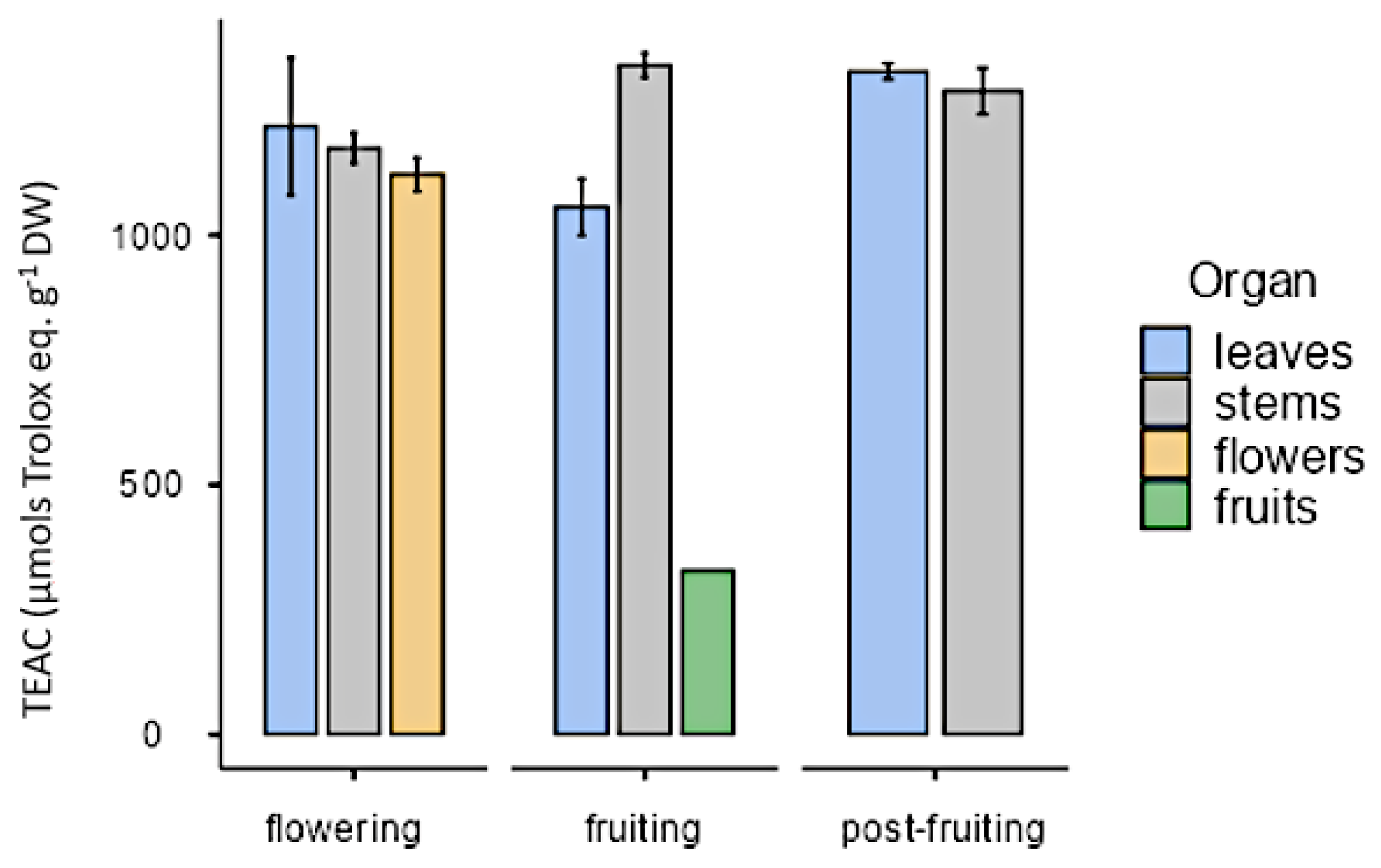
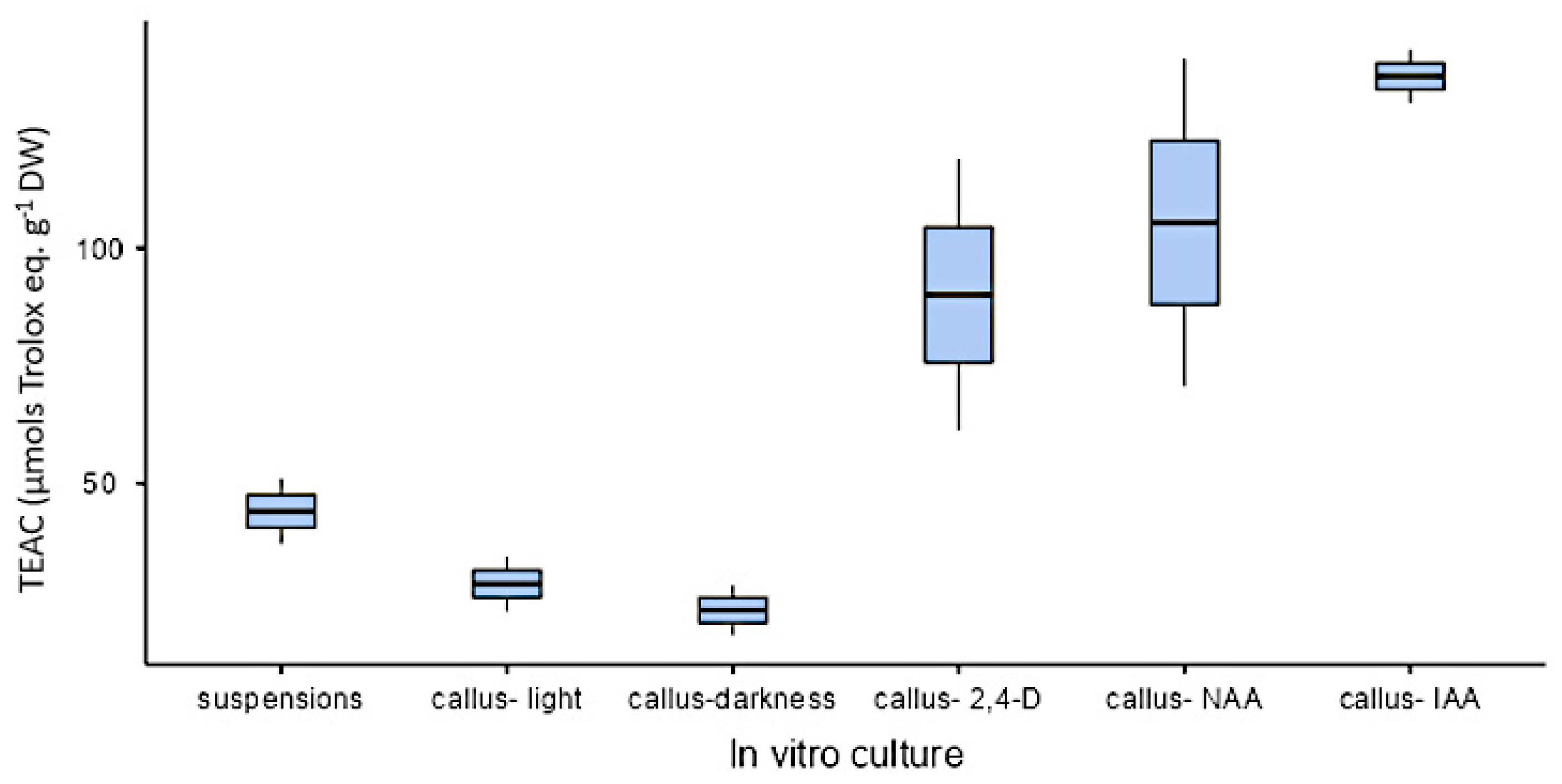
| Phenological Stage | Organ | Total Phenolics (mg Gallic Acid eq·g−1 DW) 1 |
|---|---|---|
| Flowering | Flowers | 179 ± 22.0 |
| Leaves | 168 ± 1.9 | |
| Stems | 183 ± 13.9 | |
| Fruiting | Fruits | 81.7 ± 0.00 |
| Leaves | 170 ± 4.86 | |
| Stems | 209 ± 13.7 | |
| Post-fruiting | Leaves | 207 ± 17.5 |
| Stems | 214 ± 12.1 |
| Organ | Phenological Stage | Organ | Phenological Stage | Mean Difference | SE | df | t | ptukey |
|---|---|---|---|---|---|---|---|---|
| Leaves | Flowering | Leaves | Fruiting | −2.45 | 8.74 | 24 | −0.28 | 1 |
| Leaves | Post-fruiting | −39.58 | 9.09 | 24 | −4.355 | 0.003 1 | ||
| Stems | Flowering | −15.29 | 9.58 | 24 | −1.596 | 0.609 | ||
| Stems | Fruiting | −40.87 | 8.74 | 24 | −4.674 | 0.001 1 | ||
| Stems | Post-fruiting | −45.94 | 9.09 | 24 | −5.055 | < 0.001 1 | ||
| Fruiting | Leaves | Post-fruiting | −37.13 | 8.20 | 24 | −4.527 | 0.002 1 | |
| Stems | Flowering | −12.84 | 8.74 | 24 | −1.468 | 0.686 | ||
| Stems | Fruiting | −38.42 | 7.82 | 24 | −4.912 | < 0.001 1 | ||
| Stems | Post-fruiting | −43.49 | 8.20 | 24 | −5.302 | < 0.001 1 | ||
| Post-fruiting | Stems | Flowering | 24.29 | 9.09 | 24 | 2.673 | 0.118 | |
| Stems | Fruiting | −1.29 | 8.20 | 24 | −0.157 | 1 | ||
| Stems | Post-fruiting | −6.36 | 8.57 | 24 | −0.742 | 0.974 | ||
| Stems | Flowering | Stems | Fruiting | −25.58 | 8.74 | 24 | −2.926 | 0.071 |
| Stems | Post-fruiting | −30.65 | 9.09 | 24 | −3.373 | 0.027 1 | ||
| Fruiting | Stems | Post-fruiting | −5.07 | 8.20 | 24 | −0.618 | 0.989 |
| Phenological Stage 1 | Organ 1 | Hydroxycinnamic Acids (mg Chlorogenic Acid eq·g−1 DW) |
|---|---|---|
| Flowering | Flowers | 2.05 ± 0.40 |
| Leaves | 3.02 ± 0.62 | |
| Stems | 2.50 ± 0.26 | |
| Fruiting | Fruits | 2.77 ± 0.01 |
| Leaves | 2.42 ± 0.28 | |
| Stems | 2.24 ± 0.41 | |
| Post-fruiting | Leaves | 3.06 ± 0.69 |
| Stems | 2.40 ± 0.49 |
| Phenological Stage 1 | Organ 1 | Proanthocyanidins (mg Catechin eq·g−1 DW) |
|---|---|---|
| Flowering | Flowers | 32.5 ± 9.60 |
| Leaves | 32.4 ± 7.25 | |
| Stems | 32.4 ± 5.99 | |
| Fruiting | Fruits | 23.9 ± 5.0 |
| Leaves | 29.0 ± 12.0 | |
| Stems | 32.7 ± 6.87 | |
| Post-fruiting | Leaves | 35.3 ± 5.79 |
| Stems | 34.6 ± 8.59 |
| Phenological Stage/Treatment | Organ | Concentration (mg g−1 Dry Weight) | |||||||||
|---|---|---|---|---|---|---|---|---|---|---|---|
| C | Q-3-O-gluc | Q-3-O-xil | Q-3-O-AP | Q-3-O-AF | Q-3-O-2-gal-AF | Q-3-O-R | Q-3-O-2-gal-R | Q-3-O-3-gal-R | Total | ||
| Flowering | Flowers | 8.65 *a ± 0.08 | 0.16 ± 0.02 | 0.30 *a ± 0.02 | 0.35 ± 0.15 | 0.63 *a ± 0.05 | 0.48 *a ± 0.06 | 0.83 *a ± 0.15 | 0.32 *a ± 0.06 | 0.55 *a ± 0.15 | 12.27 *a ± 0.63 |
| Flowering | Stems | 7.43 ± 0.01 | 0.18 ± 0.02 | 0.24 *b ± 0.04 | 0.33 ± 0.05 | 0.35 *b ± 0.03 | 0.33 *b ± 0.03 | 0.49 *b ± 0.03 | 0.41 *b ± 0.09 | 0.25 *b ± 0.01 | 10.01 *b ± 0.19 |
| Flowering | Leaves | 7.41 ± 0.31 | 0.32 *a ± 0.18 | 0.56 *c ± 0.01 | 0.66 *a ± 0.08 | 1.01 *c ± 0.13 | 0.82 *c ± 0.06 | 1.42 *c ± 0.58 | 0.73 *c ± 0.03 | 0.74 *c ± 0.10 | 13.71 *c ± 0.69 |
| Fruiting | Stems | 6.96 *a ± 0.84 | 0.18 ± 0.02 | 0.26 ± 0.06 | 0.28 *a ± 0.08 | 0.42 *a ± 0.12 | 0.37 *a ± 0.03 | 0.67 *a ± 0.29 | 0.50 *a ± 0.06 | 0.47 *a ± 0.05 | 10.11 *a ± 1.15 |
| Fruiting | Leaves | 8.66 *b ± 0.66 | 0.25 *a ± 0.01 | 0.32 *a ± 0.04 | 0.22 *b ± 0.04 | 0.56 *b ± 0.08 | 0.51 *b ± 0.07 | 0.91 *b ± 0.29 | 0.62 *b ± 0.04 | 0.81 *b ± 0.01 | 12.86 *b ± 0.30 |
| Fruiting | Fruit | 0.86 *c ± 0.02 | 0.20 ± 0.01 | 0.24 ± 0.02 | 0.50 *c ± 0.02 | 0.72 *c ± 0.01 | 0.72 *c ± 0.01 | 0.40 *c ± 0.02 | 0.16 *c ± 0.01 | 0.52 *c ± 0.02 | 4.32 *c ± 0.04 |
| Post-fruiting | Stems | 13.81 ± 0.98 | 0.28 ± 0.01 | 0.57 ± 0.05 | 0.63 ± 0.03 | 0.99 ± 0.09 | 0.98 ± 0.12 | 1.02 ± 0.20 | 0.54 ± 0.01 | 1.62 ± 0.97 | 20.44 ± 0.36 |
| Post-fruiting | Leaves | 12.16 ± 0.95 | 0.24 ± 0.02 | 0.89 ± 0.15 | 0.79 ± 0.13 | 1.24 ± 0.08 | 1.27 ± 0.11 | 1.65 ± 0.03 | 0.53 ± 0.11 | 0.87 ± 0.13 | 19.64 ± 0.24 |
| 2.4-D 2.5 µM | Calli | 0.99 *a ± 0.51 | 0.08 *a ± 0.01 | 0.08 *a ± 0.02 | 0.15 *a ± 0.01 | 0.19 ± 0.05 | 0.13 *a ± 0.05 | 0.31 *a ± 0.25 | 0.10 *a ± 0.08 | 0.05 *a ± 0.03 | 2.08 *a ± 0.02 |
| IAA 2.5 µM | Calli | 1.97 *b ± 0.31 | 0.11 *b ± 0.01 | 0.12 *b ± 0.04 | 0.27 *b ± 0.07 | 0.21 *a ± 0.05 | 0.10 *b ± 0.04 | 0.37 *b ± 0.29 | 0.05 *b ± 0.01 | 0.07 *b ± 0.03 | 3.27 *b ± 0.77 |
| NAA 2.5 µM | Calli | 0.60 *c ± 0.36 | 0.02 *c ± 0.02 | 0.04 *c ± 0.02 | 0.08 *c ± 0.01 | 0.09 *b ± 0.05 | 0.04 *c ± 0.02 | 0.10 *c ± 0.08 | 0.02 *c ± 0.01 | 0.01 *c ± 0.01 | 1.00 *c ± 0.48 |
| Darkness | Calli | 0.07 ± 0.01 | ND | ND | ND | 0.09 ± 0.01 | 0.07 ± 0.03 | 0.07 ± 0.03 | 0.04 ± 0.01 | 0.07 ± 0.01 | 0.40 ± 0.02 |
| Light | Calli | 0.02 ± 0.01 | 0.03 ± 0.01 | 0.07 ± 0.03 | 0.23 ± 0.05 | 0.19 ± 0.09 | 0.08 ± 0.05 | 0.19 ± 0.08 | 0.03 ± 0.01 | 0.03 ± 0.01 | 0.87 ± 0.08 |
| RC ± SD—Adult Specimen Extracts | ||||
|---|---|---|---|---|
| TA 100 + S9 | TA 100 − S9 | T 98 + S9 | TA 98 − S9 | |
| ¼ diluted extract | 0.95 ± 0.09 | 1.02 ± 0.05 | 1.01 ± 0.12 | 1.00 ± 0.05 |
| ½ diluted extract | 0.97 ± 0.04 | 1.01 ± 0.03 | 0.99 ± 0.14 | 0.96 ± 0.09 |
| Direct extract | 0.84 ± 0.04 | 0.76 ± 0.17 | 0.78 ± 0.06 | 0.86 ± 0.18 |
| RC ± SD—In Vitro Cultures Extracts | ||||
|---|---|---|---|---|
| TA 100 + S9 | TA 100 − S9 | T 98 + S9 | TA 98 − S9 | |
| ¼ diluted extract | 1.00 ± 0.07 | 1.02 ± 0.06 | 1.07 ± 0.04 | 1.04 ± 0.05 |
| ½ diluted extract | 1.03 ± 0.03 | 1.03 ± 0.04 | 1.02 ± 0.12 | 1.01 ± 0.13 |
| Direct extract | 0.92 ± 0.07 | 0.94 ± 0.04 | 1.00 ± 0.03 | 0.81 ± 0.18 |
Publisher’s Note: MDPI stays neutral with regard to jurisdictional claims in published maps and institutional affiliations. |
© 2021 by the authors. Licensee MDPI, Basel, Switzerland. This article is an open access article distributed under the terms and conditions of the Creative Commons Attribution (CC BY) license (https://creativecommons.org/licenses/by/4.0/).
Share and Cite
Ricco, M.V.; Bari, M.L.; Catalano, A.V.; López, P.; Dobrecky, C.B.; Teves, S.A.; Posadaz, A.; Laguia Becher, M.; Ricco, R.A.; Wagner, M.L.; et al. Dynamics of Polyphenol Biosynthesis by Calli Cultures, Suspension Cultures and Wild Specimens of the Medicinal Plant Ligaria cuneifolia (Ruiz & Pav.) Tiegh. (Loranthaceae). Analysis of Their Biological Activity. Plants 2021, 10, 1713. https://doi.org/10.3390/plants10081713
Ricco MV, Bari ML, Catalano AV, López P, Dobrecky CB, Teves SA, Posadaz A, Laguia Becher M, Ricco RA, Wagner ML, et al. Dynamics of Polyphenol Biosynthesis by Calli Cultures, Suspension Cultures and Wild Specimens of the Medicinal Plant Ligaria cuneifolia (Ruiz & Pav.) Tiegh. (Loranthaceae). Analysis of Their Biological Activity. Plants. 2021; 10(8):1713. https://doi.org/10.3390/plants10081713
Chicago/Turabian StyleRicco, María Valeria, Martín León Bari, Alejandra Vanina Catalano, Paula López, Cecilia Beatriz Dobrecky, Sergio Adrián Teves, Ariana Posadaz, Melina Laguia Becher, Rafael Alejandro Ricco, Marcelo Luis Wagner, and et al. 2021. "Dynamics of Polyphenol Biosynthesis by Calli Cultures, Suspension Cultures and Wild Specimens of the Medicinal Plant Ligaria cuneifolia (Ruiz & Pav.) Tiegh. (Loranthaceae). Analysis of Their Biological Activity" Plants 10, no. 8: 1713. https://doi.org/10.3390/plants10081713
APA StyleRicco, M. V., Bari, M. L., Catalano, A. V., López, P., Dobrecky, C. B., Teves, S. A., Posadaz, A., Laguia Becher, M., Ricco, R. A., Wagner, M. L., & Álvarez, M. A. (2021). Dynamics of Polyphenol Biosynthesis by Calli Cultures, Suspension Cultures and Wild Specimens of the Medicinal Plant Ligaria cuneifolia (Ruiz & Pav.) Tiegh. (Loranthaceae). Analysis of Their Biological Activity. Plants, 10(8), 1713. https://doi.org/10.3390/plants10081713







